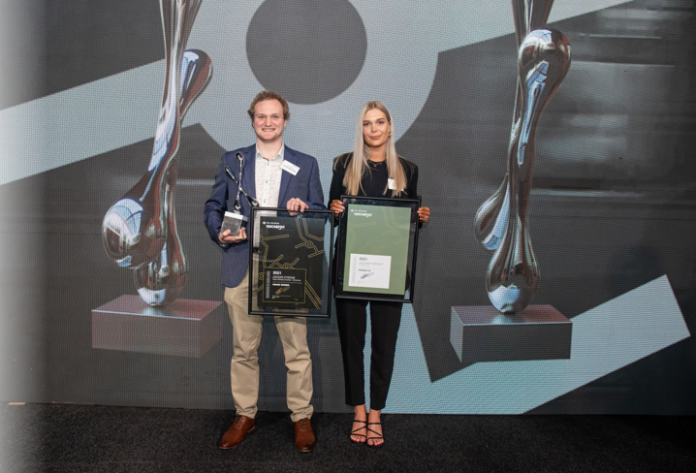Zander Etienne Deysel, architecture student at Nelson Mandela University, has been announced as the winner of the prestigious 2021 PG Bison Education Initiative, winning a cash prize of R50 000 (and R50 000 for his lecturer too).
Second place was scooped by Ashleigh Bennett, interior design student at IIE Vega, Durban, taking home R25 000. After intense deliberation, the 2021 judging panel decided not to award a third place this year, as despite the high level of talent on display in the 10 finalists’ work, the judges felt that none of the remaining eight submissions adequately met each and every requirement of the brief.
“Congratulations to Zander and Ashleigh, as well as their lecturers,” says Lian Markham, Communications Manager at PG Bison. “We were very impressed with their submissions, which focused on creating a tourism-centered solution for the Strand Street Quarry in Cape Town. The judges felt that beyond the design elements, the winning and second-place entries also took into account the unique cultural, historical and community context of the site, which was a critical part of the brief. We wish them and the rest of the finalists well-deserved congratulations and all the best for their budding careers in architecture and interior design – we look forward to seeing the work they will produce as they enter the workplace. We hope this competition has provided a showcase for their skills and that it will unlock new opportunities for each one of them.”
The winning entry
Deysel is thrilled at taking the win. “It is the highest honour that I have received up to this point and will help me to build and develop my career in architecture,” he enthuses. “In terms of the cash prize, a certain amount will go towards helping with my studies and the rest will be kept for future use.”
His winning submission is called Four Pillar Terminal – Revitalizing the Quarry. “It is specifically designed to create social spaces for human interaction, while still incorporating the terminal aspect of the building and the environment around it. The local Bo-Kaap heritage is represented by four large pillars, each colour coded in a different colour. With beautiful views to Table Mountain, Signal Hill, Lion’s Head, and the ocean, this would be a building for everyone to visit.”
Deysel says the hardest part of the brief was not being from Cape Town, which meant he was unable to physically visit the site. “The hardest part of the brief for me was designing a functional building that was sensitive to its context and integrated the local Bo-Kaap heritage and community, but I believe my building stands out because it acts as an extension to the quarry cliff with a rooftop promenade that allows for beautiful views all over Cape Town. By doing this, the building has minimal impact on the site and this allows for the site to be landscaped and social spaces to be created, revitalizing the quarry, and maintaining its heritage. Retail pods were also designed for the use of the local Bo-Kaap community.”
Nelson Mandela University has enjoyed many successes in the 1.618 Education Initiative over the years, with architecture lecturers Donald Flint and Barry Bradley having assisted many of their students to develop top submissions, including 2019 winner, Sanette de Villiers.

Starting with staples
Runner-up, Ashleigh Bennett, enjoys learning how to use new technology, such as modelling and rendering programs. Her lecturer at IIE Vega Durban is Carolanda du Toit.
For her entry, Bennett decided a 3D model would be a good start. “I grabbed the most ideal objects closest to me – staples – and began modelling,” she says. “I quickly realised the meaning behind staples: joining, connecting, binding and healing. This was the perfect concept for the brief. This concept inspired me to create a space that connects the past with the present, the locals with the tourists, and brings people, as well as heritage destinations, together. The goal was to create a space that is an experience within itself. This was done with experiential draw cards such as Malay cuisine cooking classes and Teppanyaki style restaurant tables. Incorporating local Malay traders and making use of colour, pattern and a Cape Dutch architecture style in a contemporary way merged the past with the present. The building design is reflective of the quarry site by making use of raw stone to merge with the land. My ideas centre around uplifting, healing and breathing new life to Bo-Kaap, the community and the heritage route.”
She says coming second is an honour and she hopes to enjoy professional exposure from the competition. She plans to use her prize money either to invest in further education or as seed funding for a start-up interior design firm that offers user-centred design while taking sustainability into consideration. “My dream job would be working at an Interior design and architecture firm, being able to participate in exciting projects and be able to watch my own designs being created in real life,” she says. “This will provide knowledge and experience to one day be able to start my own interior design.”
The awards experience
While the 2020 edition of the PG Bison 1.618 Education Initiative had to move online due to COVID-19, the 2021 edition was a hybrid event. All the finalists were brought to Johannesburg for the filming of the awards ceremony, which was streamed live so their families, friends, lecturers and the PG Bison community could be part of the experience. They enjoyed hotel accommodation and a celebratory dinner, as well as the chance to meet one another, and key competition representatives. Each finalist will also receive a cash prize of R2 000.
The remaining eight finalists were:
- Alexia Ausserhoffer from CAD4ALL Institute of Applied Architecture (interior design student)
- Mikayla Louw from CAD4ALL Institute of Applied Architecture (interior design student)
- Bianca de Villiers from Design Time School of Interior Design (interior design student)
- Dewan Kemp from IIE Vega Cape Town (interior design student)
- Tasmin Fourie from IIE Vega Cape Town (interior design student)
- Ivan Bester from Nelson Mandela University (architecture student)
- Joshua Baynes from Nelson Mandela University (architecture student)
- Lucky Tsotetsi from University of Johannesburg (architecture student)
“It was wonderful to meet all the finalists in person,” says Markham. “Every year, the location of the winning institution becomes the location for the next year’s brief, so we are already hard at work on the 2022 brief, which will be set in Gqerberha (Port Elizabeth). We look forward to announcing the new brief soon.”






